sensor RENAULT TWINGO RS 2009 2.G Electrical Equipment - Petrol Injection Workshop Manual
[x] Cancel search | Manufacturer: RENAULT, Model Year: 2009, Model line: TWINGO RS, Model: RENAULT TWINGO RS 2009 2.GPages: 348
Page 2 of 348
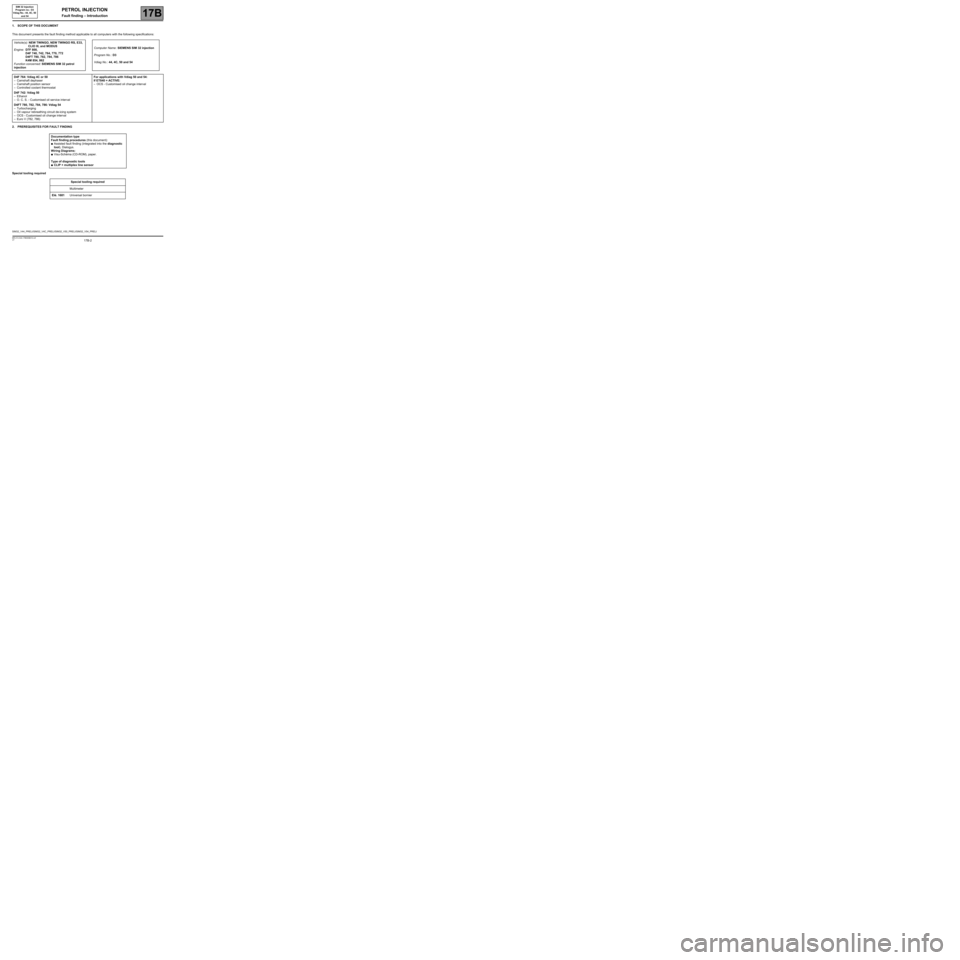
17B-2V7 MR-413-X44-17B000$010.mif
17B
SIM 32 Injection
Program no.: D3
Vdiag No.: 44, 4C, 50
and 54
1. SCOPE OF THIS DOCUMENT
This document presents the fault finding method applicable to all computers with the following specifications:
2. PREREQUISITES FOR FAULT FINDING
Special tooling requiredVehicle(s): NEW TWINGO, NEW TWINGO RS, E33,
CLIO III, and MODUS
Engine:D7F 800,
D4F 740, 742, 764, 770, 772
D4FT 780, 782, 784, 786
K4M 854, 862
Function concerned: SIEMENS SIM 32 petrol
injection Computer Name: SIEMENS SIM 32 injection
Program No.: D3
Vdiag No.: 44, 4C, 50 and 54
D4F 764: Vdiag 4C or 50
–Camshaft dephaser
–Camshaft position sensor
–Controlled coolant thermostat
D4F 742: Vdiag 50
–Ethanol
–O. C. S. - Customised oil service interval
D4FT 780, 782, 784, 786: Vdiag 54
–Turbocharging
–Oil vapour rebreathing circuit de-icing system
–OCS - Customised oil change interval
–Euro V (782, 786)For applications with Vdiag 50 and 54:
If ET840 = ACTIVE:
–OCS - Customised oil change interval
Documentation type
Fault finding procedures (this document):
●Assisted fault finding (integrated into the diagnostic
tool), Dialogys.
Wiring Diagrams:
●Visu-Schéma (CD-ROM), paper.
Type of diagnostic tools
●CLIP + multiplex line sensor
Special tooling required
Multimeter
Elé. 1681Universal bornier
SIM32_V44_PRELI/SIM32_V4C_PRELI/SIM32_V50_PRELI/SIM32_V54_PRELI
PETROL INJECTION
Fault finding – Introduction
Page 10 of 348
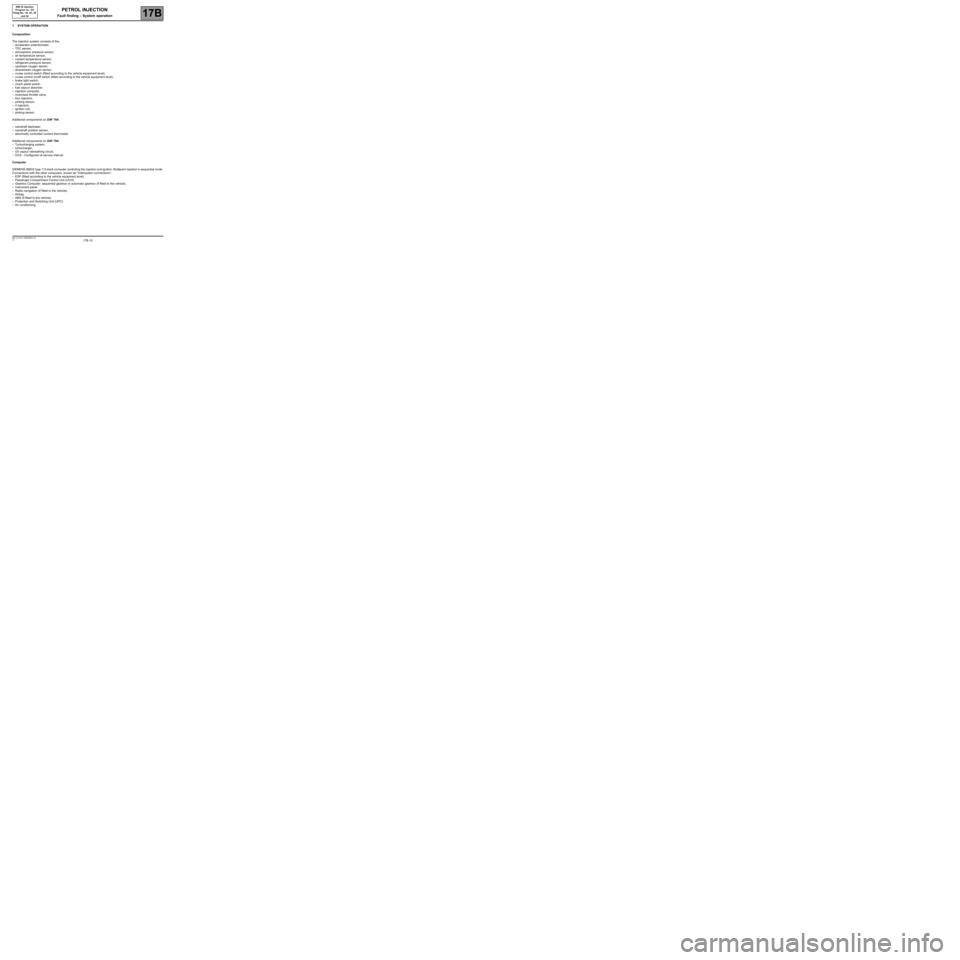
17B-10V7 MR-413-X44-17B000$030.mif
17B
SIM 32 Injection
Program no.: D3
Vdiag No.: 44, 4C, 50
and 54
1. SYSTEM OPERATION
Composition
The injection system consists of the:
–accelerator potentiometer,
–TDC sensor,
–atmospheric pressure sensor,
–air temperature sensor,
–coolant temperature sensor,
–refrigerant pressure sensor,
–upstream oxygen sensor,
–downstream oxygen sensor,
–cruise control switch (fitted according to the vehicle equipment level),
–cruise control on/off switch (fitted according to the vehicle equipment level),
–brake light switch,
–clutch pedal switch,
–fuel vapour absorber,
–injection computer,
–motorised throttle valve,
–four injectors,
–pinking sensor,
–4 injectors,
–ignition coil,
–pinking sensor.
Additional components on D4F 764:
–camshaft dephaser,
–camshaft position sensor,
–electrically controlled coolant thermostat.
Additional components on D4F 784:
–Turbocharging system,
–turbocharger,
–Oil vapour rebreathing circuit,
–OCS - Configured oil service interval.
Computer
SIEMENSSIM32type112-track co mputer controlling the injection a nd ignition. M ultipoint injection in se quential mode.
Connections with the other computers, known as "Intersystem connections":
–ESP (fitted according to the vehicle equipment level).
–Passenger Compartment Control Unit (UCH).
–Gearbox Computer: sequential gearbox or automatic gearbox (if fitted to the vehicle).
–Instrument panel.
–Radio navigation (if fitted to the vehicle).
–Airbag.
–ABS (if fitted to the vehicle).
–Protection and Switching Unit (UPC).
–Air conditioning.
PETROL INJECTION
Fault finding – System operation
Page 11 of 348
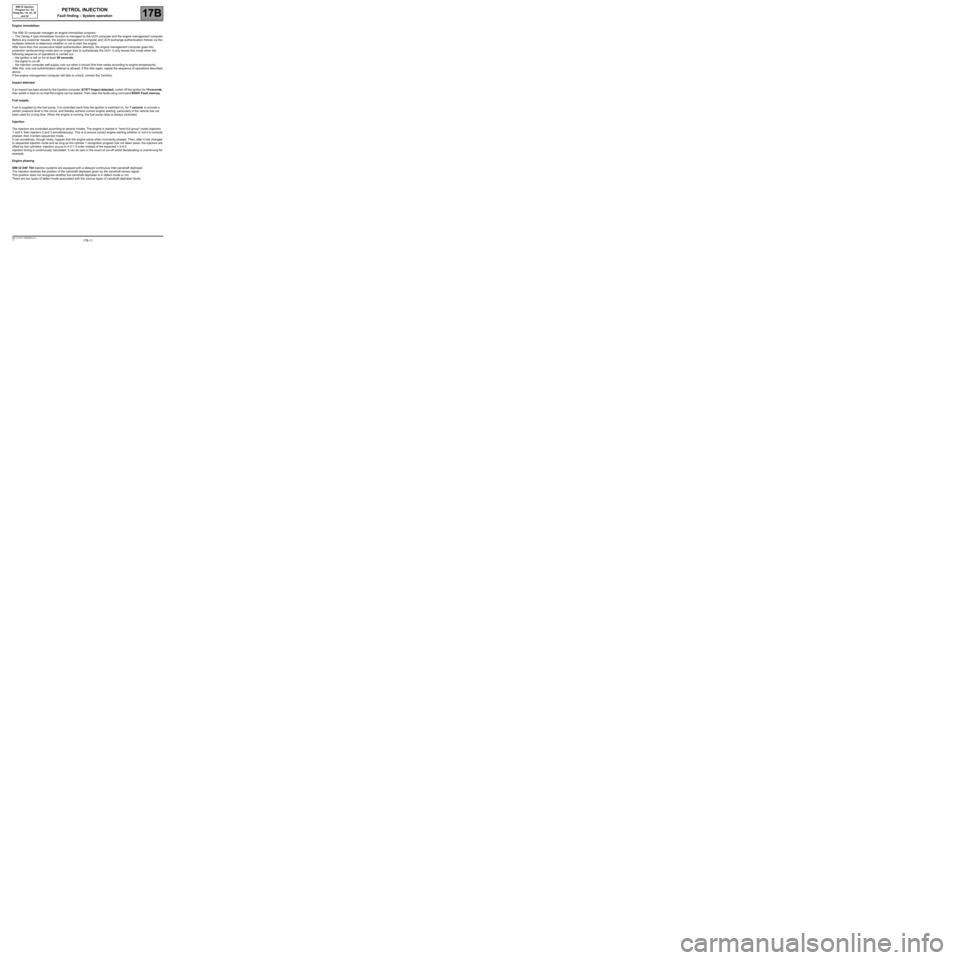
17B-11V7 MR-413-X44-17B000$030.mif
PETROL INJECTION
Fault finding – System operation17B
SIM 32 Injection
Program no.: D3
Vdiag No.: 44, 4C, 50
and 54
Engine immobiliser
The SIM 32 computer manages an engine immobiliser program:
–The Verlog 4 type immobiliser function is managed by the UCH computer and the engine management computer.
Before any customer request, the engine management computer and UCH exchange authentication frames via the
multiplex network to determine whether or not to start the engine.
After more than five consecutive failed authentication attempts, the engine management computer goes into
protection (antiscanning) mode and no longer tries to authenticate the UCH. It only leaves this mode when the
following sequence of operations is carried out:
–the ignition is left on for at least 60 seconds,
–the signal is cut off,
–the injection computer self-supply cuts out when it should (the time varies according to engine temperature).
After this, only one authentication attempt is allowed. If this fails again, repeat the sequence of operations described
above.
If the engine management computer still fails to unlock, contact the Techline.
Impact detected
If an impacthas been stored by the injection computer (ET077 Impactdetected), switch off the ignition for10 seconds,
thenswitch it back on so that the e ngine can b e started. Then clear the faults using commandRZ0 01 Fault memory.
Fuel supply
Fuel is supplied by the fuel pump. It is controlled each time the ignition is switched on, for 1 second, to provide a
certain pressure level in the circuit, and thereby achieve correct engine starting, particularly if the vehicle has not
been used for a long time. When the engine is running, the fuel pump relay is always controlled.
Injection
The injectors are controlled according to several modes. The engine is started in "semi-full group" mode (injectors
1 and 4, then injectors 2 and 3 simultaneously). This is to ensure correct engine starting whether or not it is correctly
phased, then it enters sequential mode.
It can sometimes, though rarely, happen that the engine starts when incorrectly phased. Then, after it has changed
to sequential injection mode and as long as the cylinder 1 recognition program has not taken place, the injectors are
offset by two cylinders: injection occurs in 4-2-1-3 order instead of the expected 1-3-4-2.
Injection timing is continuously calculated. It can be zero in the event of cut-off whilst decelerating or overrevving for
example.
Engine phasing
SIM 32 D4F 764 injection systems are equipped with a delayed continuous inlet camshaft dephaser.
The injection receives the position of the camshaft dephaser given by the camshaft sensor signal.
This position does not recognise whether the camshaft dephaser is in defect mode or not.
There are two types of defect mode associated with the various types of camshaft dephaser faults:
Page 13 of 348
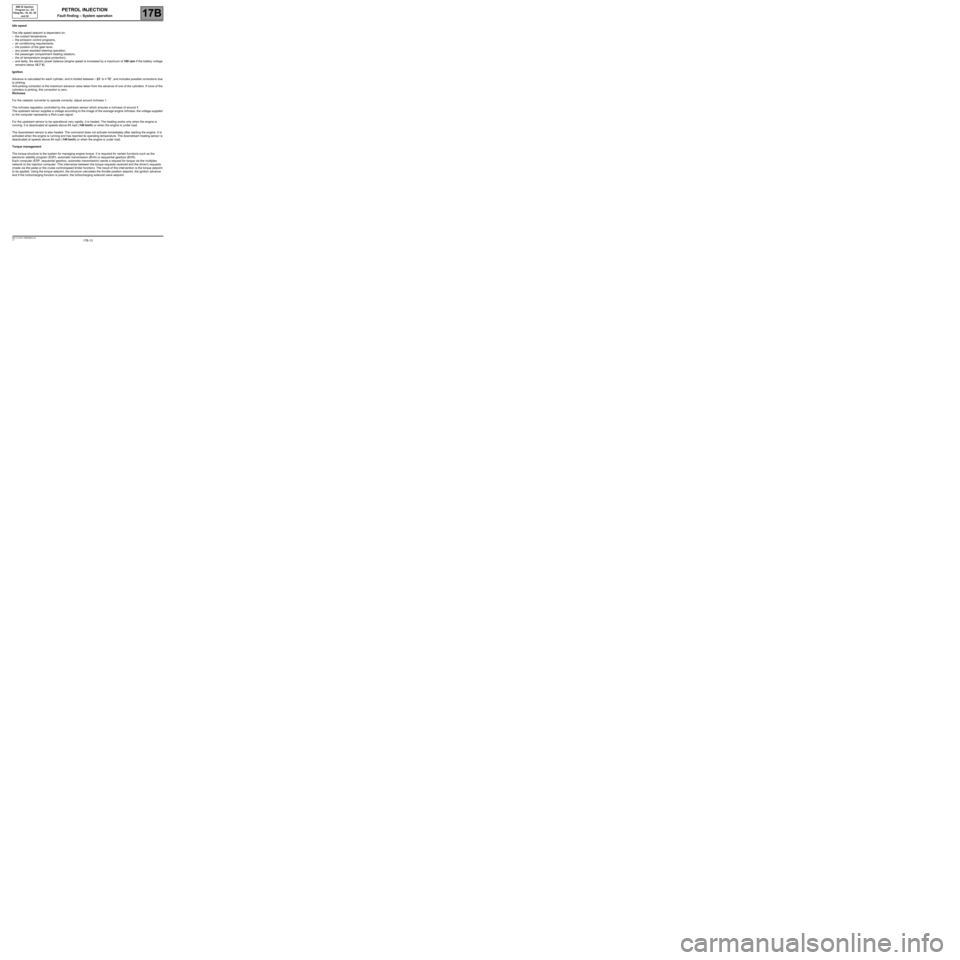
17B-13V7 MR-413-X44-17B000$030.mif
PETROL INJECTION
Fault finding – System operation17B
SIM 32 Injection
Program no.: D3
Vdiag No.: 44, 4C, 50
and 54
Idle speed
The idle speed setpoint is dependent on:
–the coolant temperature,
–the emission control programs,
–air conditioning requirements,
–the position of the gear lever,
–any power-assisted steering operation,
–the passenger compartment heating resistors,
–the oil temperature (engine protection),
–and lastly, the electric power balance (engine speed is increased by a maximum of 160 rpm if the battery voltage
remains below 12.7 V).
Ignition
Advance is calculated for each cylinder, and is limited between - 23˚ to + 72˚, and includes possible corrections due
to pinking.
Anti-pinking correction is the maximum advance value taken from the advance of one of the cylinders. If none of the
cylinders is pinking, this correction is zero.
Richness
For the catalytic converter to operate correctly, adjust around richness 1.
The richness regulation controlled by the upstream sensor which ensures a richness of around 1.
The upstream sensor supplies a voltage according to the image of the average engine richness: the voltage supplied
to the computer represents a Rich-Lean signal.
For the upstream sensor to be operational very rapidly, it is heated. The heating works only when the engine is
running. It is deactivated at speeds above 84 mph (140 km/h) or when the engine is under load.
The downstream sensor is also heated. The command does not activate immediately after starting the engine. It is
activated when the engine is running and has reached its operating temperature. The downstream heating sensor is
deactivated at speeds above 84 mph (140 km/h) or when the engine is under load.
Torque management
The torque structure is the system for managing engine torque. It is required for certain functions such as the
electronic stability program (ESP), automatic transmission (BVA) or sequential gearbox (BVR).
Each computer (ESP, sequential gearbox, automatic transmission) sends a request for torque via the multiplex
network to the injection computer. This intervenes between the torque requests received and the driver's requests
(made via the pedal or the cruise control/speed limiter function). The result of this intervention is the torque setpoint
to be applied. Using the torque setpoint, the structure calculates the throttle position setpoint, the ignition advance
and if the turbocharging function is present, the turbocharging solenoid valve setpoint.
Page 14 of 348
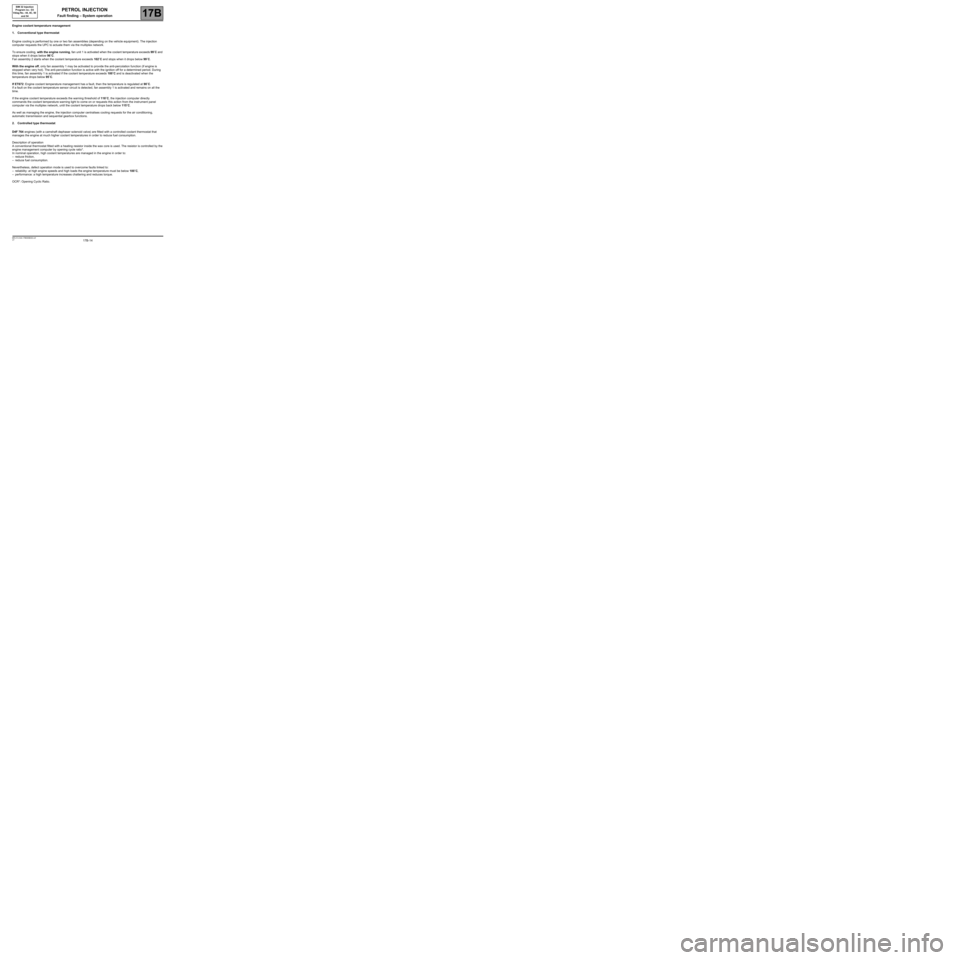
17B-14V7 MR-413-X44-17B000$030.mif
PETROL INJECTION
Fault finding – System operation17B
SIM 32 Injection
Program no.: D3
Vdiag No.: 44, 4C, 50
and 54
Engine coolant temperature management
1. Conventional type thermostat
Engine cooling is performed by one or two fan assemblies (depending on the vehicle equipment). The injection
computer requests the UPC to actuate them via the multiplex network.
To ensure cooling, with the engine running, fan unit 1 is activated when the coolant temperature exceeds 99˚C and
stops when it drops below 96˚C.
Fan assembly 2 starts when the coolant temperature exceeds 102˚C and stops when it drops below 99˚C.
With the engine off, only fan assembly 1 may be activated to provide the anti-percolation function (if engine is
stopped when very hot). The anti-percolation function is active with the ignition off for a determined period. During
this time, fan assembly 1 is activated if the coolant temperature exceeds 100˚C and is deactivated when the
temperature drops below 95˚C.
If ET672: Engine coolant temperature management has a fault, then the temperature is regulated at 90˚C.
If a fault on the coolant temperature sensor circuit is detected, fan assembly 1 is activated and remains on all the
time.
If the engine coolant temperature exceeds the warning threshold of 118˚C, the injection computer directly
commands the coolant temperature warning light to come on or requests this action from the instrument panel
computer via the multiplex network, until the coolant temperature drops back below 115˚C.
As well as managing the engine, the injection computer centralises cooling requests for the air conditioning,
automatic transmission and sequential gearbox functions.
2. Controlled type thermostat
D4F 764 engines (with a camshaft dephaser solenoid valve) are fitted with a controlled coolant thermostat that
manages the engine at much higher coolant temperatures in order to reduce fuel consumption.
Description of operation
A conventional thermostat fitted with a heating resistor inside the wax core is used. The resistor is controlled by the
engine management computer by opening cycle ratio*.
In nominal operation, high coolant temperatures are managed in the engine in order to:
–reduce friction,
–reduce fuel consumption.
Nevertheless, defect operation mode is used to overcome faults linked to:
–reliability: at high engine speeds and high loads the engine temperature must be below 100˚C,
–performance: a high temperature increases chattering and reduces torque.
OCR*: Opening Cyclic Ratio.
Page 15 of 348
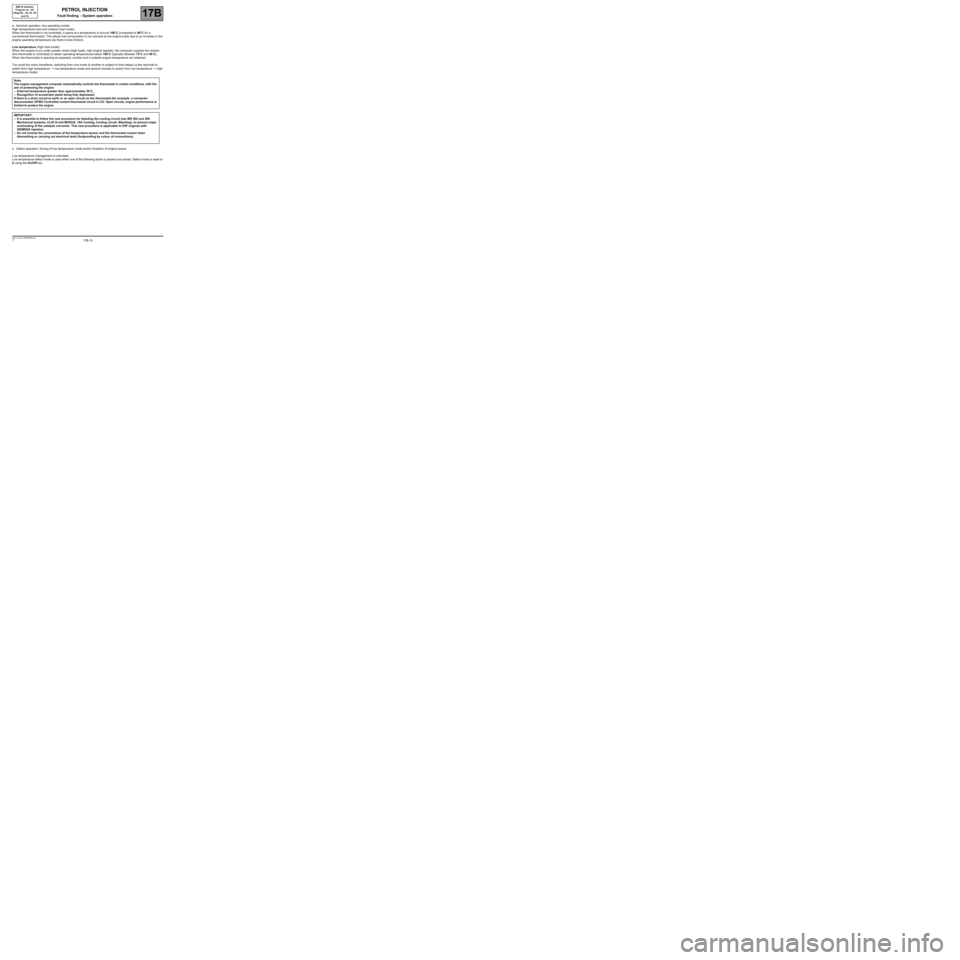
17B-15V7 MR-413-X44-17B000$030.mif
PETROL INJECTION
Fault finding – System operation17B
SIM 32 Injection
Program no.: D3
Vdiag No.: 44, 4C, 50
and 54
a. Nominal operation: two operating modes.
High temperature (low and medium load mode):
When the thermostat is not controlled, it opens at a temperature of around 108˚C (compared to 89˚C for a
conventional thermostat). This allows fuel consumption to be reduced at low engine loads due to an increase in the
engine operating temperature (as there is less friction).
Low temperature (high load mode):
When the engine is put under greater stress (high loads, high engine speeds), the computer supplies the resistor
(the thermostat is controlled) to obtain operating temperatures below 108˚C (typically between 75˚C and 90˚C).
When the thermostat is opening as expected, comfort and a suitable engine temperature are obtained.
Too avoid too many transitions, switching from one mode to another is subject to time delays (a few seconds to
switch from high temperature
→ low temperature mode and several minutes to switch from low temperature → high
temperature mode).
b. Defect operation: forcing of low temperature mode and/or limitation of engine torque.
Low temperature management is activated.
Low temperature defect mode is used when one of the following faults is present and stored. Defect mode is reset to
0 using the On/Off key. Note:
The engine management computer automatically controls the thermostat in certain conditions, with the
aim of protecting the engine:
–External temperature greater than approximately 30˚C,
–Recognition of accelerator pedal being fully depressed.
If there is a short circuit to earth or an open circuit on the thermostat (for example: a connector
disconnected, DF893 Controlled coolant thermostat circuit in CO: Open circuit), engine performance is
limited to protect the engine.
IMPORTANT:
–It is essential to follow the new procedure for bleeding the cooling circuit (see MR 392 and 385,
Mechanical systems, CLIO III and MODUS, 19A Cooling, Cooling circuit: Bleeding), to prevent major
overheating of the catalytic converter. This new procedure is applicable to D4F engines with
SIEMENS injection.
–Do not inverse the connections of the temperature sensor and the thermostat control when
dismantling or carrying out electrical tests (foolproofing by colour of connections).
Page 16 of 348
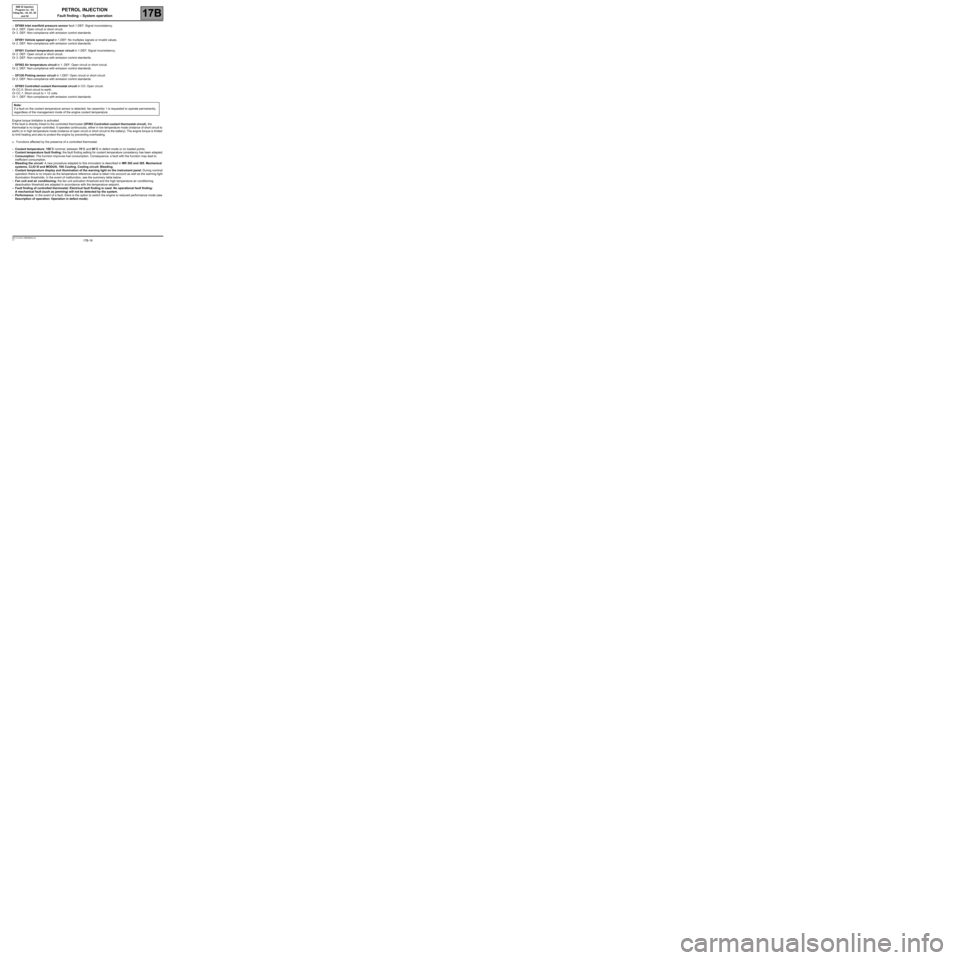
17B-16V7 MR-413-X44-17B000$030.mif
PETROL INJECTION
Fault finding – System operation17B
SIM 32 Injection
Program no.: D3
Vdiag No.: 44, 4C, 50
and 54
–DF089 Inlet manifold pressure sensor fault 1.DEF: Signal inconsistency.
Or 2. DEF: Open circuit or short circuit.
Or 3. DEF: Non-compliance with emission control standards.
–DF091 Vehicle speed signal in 1.DEF: No multiplex signals or invalid values.
Or 2. DEF: Non-compliance with emission control standards.
–DF001 Coolant temperature sensor circuit in 1.DEF: Signal inconsistency.
Or 2. DEF: Open circuit or short circuit.
Or 3. DEF: Non-compliance with emission control standards.
–DF002 Air temperature circuit in 1. DEF: Open circuit or short circuit.
Or 2. DEF: Non-compliance with emission control standards.
–DF330 Pinking sensor circuit in 1.DEF: Open circuit or short circuit.
Or 2. DEF: Non-compliance with emission control standards.
–DF893 Controlled coolant thermostat circuit in CO: Open circuit.
Or CC.0: Short circuit to earth.
Or CC.1: Short circuit to + 12 volts.
Or 1. DEF: Non-compliance with emission control standards.
Engine torque limitation is activated.
If the fault is directly linked to the controlled thermostat (DF893 Controlled coolant thermostat circuit), the
thermostat is no longer controlled. It operates continuously, either in low temperature mode (instance of short circuit to
earth) or in high temperature mode (instance of open circuit or short circuit to the battery). The engine torque is limited
to limit heating and also to protect the engine by preventing overheating.
c. Functions affected by the presence of a controlled thermostat:
–Coolant temperature: 108˚C nominal, between 70˚C and 90˚C in defect mode or on loaded points.
–Coolant temperature fault finding: the fault finding setting for coolant temperature consistency has been adapted.
–Consumption: The function improves fuel consumption. Consequence: a fault with the function may lead to
inefficient consumption.
–Bleeding the circuit: A new procedure adapted to this innovation is described in MR 392 and 385, Mechanical
systems, CLIO III and MODUS, 19A Cooling, Cooling circuit: Bleeding.
–Coolant temperature display and illumination of the warning light on the instrument panel: During nominal
operation there is no impact as the temperature reference value is taken into account as well as the warning light
illumination thresholds. In the event of malfunction, see the summary table below.
–Fan unit and air conditioning: the fan unit activation threshold and the high temperature air conditioning
deactivation threshold are adapted in accordance with the temperature setpoint.
–Fault finding of controlled thermostat: Electrical fault finding is used. No operational fault finding:
A mechanical fault (such as jamming) will not be detected by the system.
–Performance: In the event of a fault, there is the option to switch the engine to reduced performance mode (see
Description of operation: Operation in defect mode). Note:
If a fault on the coolant temperature sensor is detected, fan assembly 1 is requested to operate permanently,
regardless of the management mode of the engine coolant temperature.
Page 17 of 348
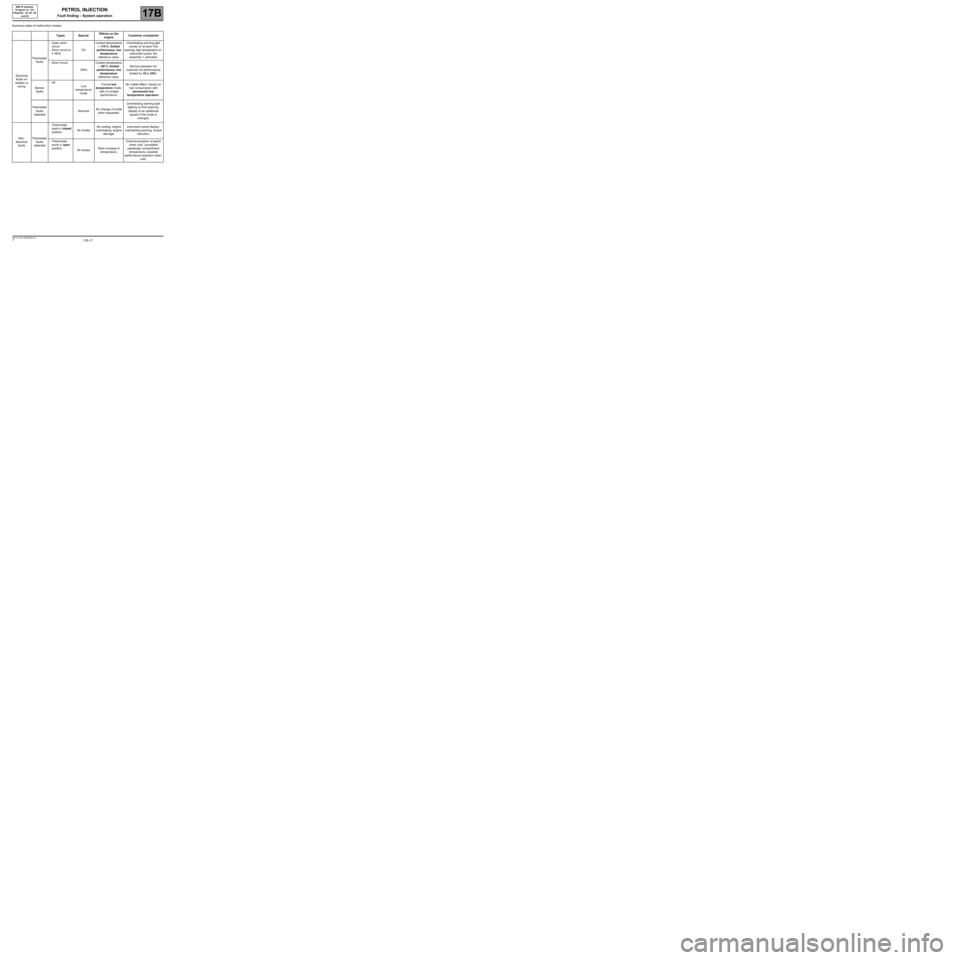
17B-17V7 MR-413-X44-17B000$030.mif
PETROL INJECTION
Fault finding – System operation17B
SIM 32 Injection
Program no.: D3
Vdiag No.: 44, 4C, 50
and 54
Summary table of malfunction modes:
Types SpecialEffects on the
engineCustomer complaints
Electrical
faults on
resistor or
wiringThermostat
faults–Open short
circuit
–Short circuit to
+ 12 V0%Coolant temperature
≈ 110˚C, limited
performance, low
temperature
reference value.Overheating warning light
comes on at each first
opening, high temperature on
instrument panel, fan
assembly 1 activated.
–Short circuit
100%Coolant temperature
≈ 90˚C, limited
performance, low
temperature
reference value.Normal operation for
customer but performance
limited by 10 to 20%.
Sensor
faults–All
Low
temperature
modeForced low
temperature mode,
with no limited
performance.No visible effect, impact on
fuel consumption with
permanent low
temperature operation.
Thermostat
faults
detectedNominalNo change of mode
when requested.Overheating warning light
lighting on first opening,
display of an additional
square if the mode is
changed.
Non-
electrical
faultsThermostat
faults
detected–Thermostat
stuck in closed
positionAll modesNo cooling, engine
overheating, engine
damage.Instrument panel display,
overheating warning, torque
reduction.
–Thermostat
stuck in open
position
All modesSlow increase in
temperature.Overconsumption of petrol
when cold, unsuitable
passenger compartment
temperature, possible
performance reduction when
cold.
Page 19 of 348
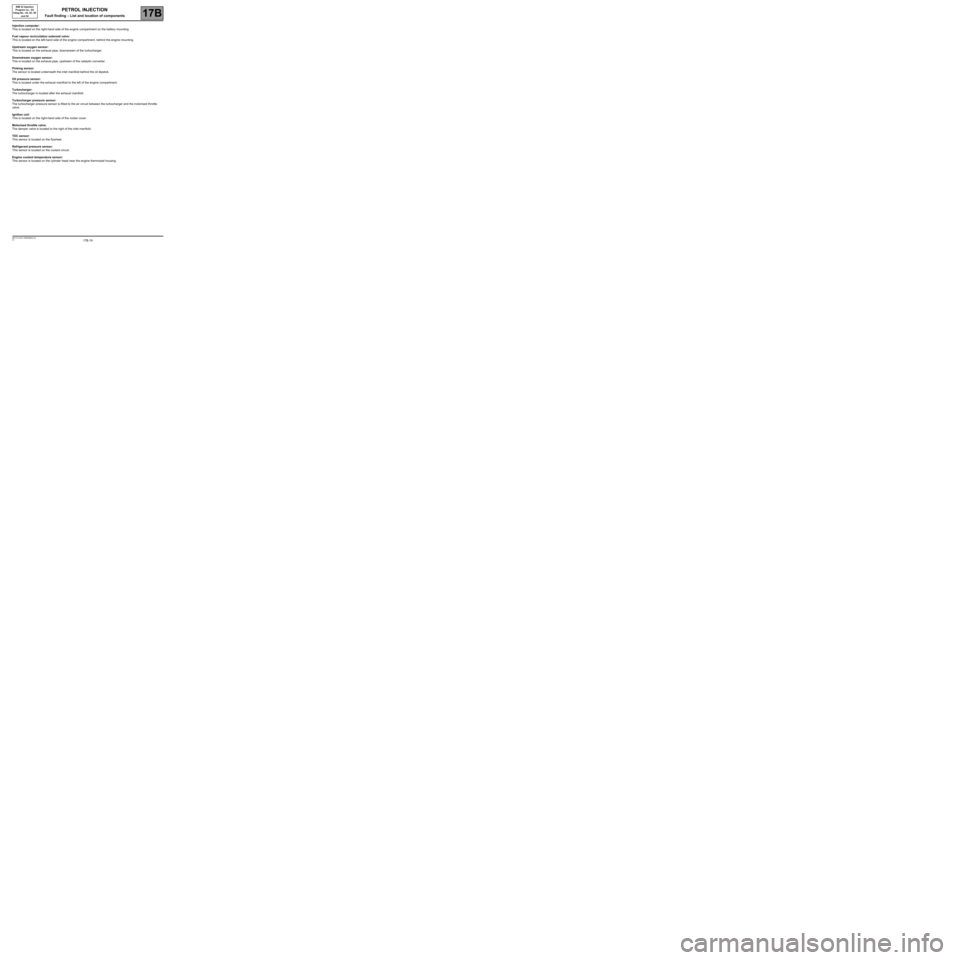
17B-19V7 MR-413-X44-17B000$040.mif
17B
SIM 32 Injection
Program no.: D3
Vdiag No.: 44, 4C, 50
and 54
Injection computer:
This is located on the right-hand side of the engine compartment on the battery mounting.
Fuel vapour recirculation solenoid valve:
This is located on the left-hand side of the engine compartment, behind the engine mounting.
Upstream oxygen sensor:
This is located on the exhaust pipe, downstream of the turbocharger.
Downstream oxygen sensor:
This is located on the exhaust pipe, upstream of the catalytic converter.
Pinking sensor:
The sensor is located underneath the inlet manifold behind the oil dipstick.
Oil pressure sensor:
This is located under the exhaust manifold to the left of the engine compartment.
Turbocharger:
The turbocharger is located after the exhaust manifold.
Turbocharger pressure sensor:
The turbocharger pressure sensor is fitted to the air circuit between the turbocharger and the motorised throttle
valve.
Ignition coil:
This is located on the right-hand side of the rocker cover.
Motorised throttle valve:
The damper valve is located to the right of the inlet manifold.
TDC sensor:
This sensor is located on the flywheel.
Refrigerant pressure sensor:
This sensor is located on the coolant circuit.
Engine coolant temperature sensor:
This sensor is located on the cylinder head near the engine thermostat housing.
PETROL INJECTION
Fault finding – List and location of components
Page 20 of 348
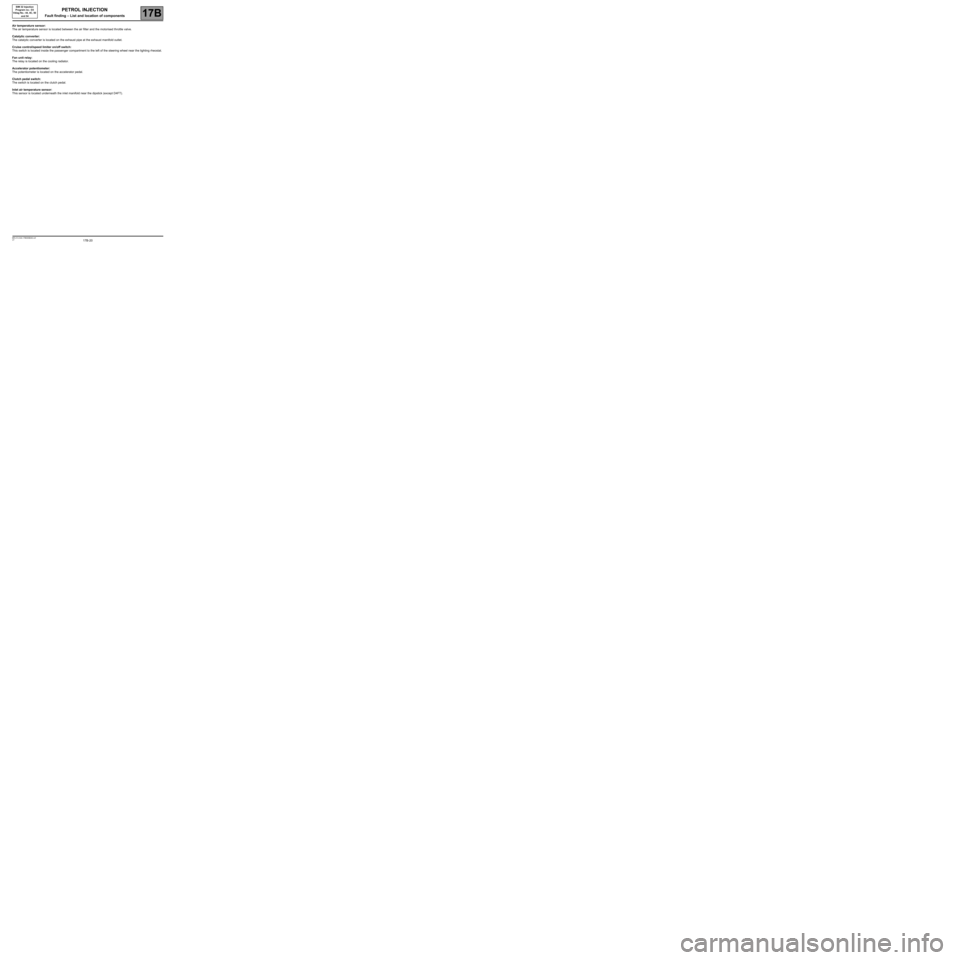
17B-20V7 MR-413-X44-17B000$040.mif
PETROL INJECTION
Fault finding – List and location of components17B
SIM 32 Injection
Program no.: D3
Vdiag No.: 44, 4C, 50
and 54
Air temperature sensor:
The air temperature sensor is located between the air filter and the motorised throttle valve.
Catalytic converter:
The catalytic converter is located on the exhaust pipe at the exhaust manifold outlet.
Cruise control/speed limiter on/off switch:
This switch is located inside the passenger compartment to the left of the steering wheel near the lighting rheostat.
Fan unit relay:
The relay is located on the cooling radiator.
Accelerator potentiometer:
The potentiometer is located on the accelerator pedal.
Clutch pedal switch:
The switch is located on the clutch pedal.
Inlet air temperature sensor:
This sensor is located underneath the inlet manifold near the dipstick (except D4FT).